
FOR THE SUMMER of 2023, Terry and I decided on a European cycling tour. I did my homework, and after a thorough appraisal of prospects, we chose a bike-and-barge tour along the picturesque Mosel River Valley, renowned for its legendary Riesling vineyards. With this core component of our trip secured, we then pieced together the rest of the itinerary, culminating in a comprehensive, 20-day European vacation. Done and dusted.
Our plan was to fly into Paris for a short stay before embarking on the bike tour. After that, we would visit Terry's brother and sister-in-law in Berlin. In total, our travels would span three countries: France, Luxembourg, and Germany. The details were falling into place. All we had to do now was start packing, right? No.
Leading up to our departure, I found myself in a race against time to ensure that my new passport was processed and delivered to me. During the Pandemic, two million Americans had let their passports expire (for the record, I was not one of them). Now everyone was wanting to travel overseas again, and the State Department was hit with an avalanche of renewal requests. What once took weeks to process, now took months. Despite the down-to-the-wire nature of this debacle, I am pleased to report that everything ultimately fell into place (after much hand-wringing). So, without further ado, on the Paris…
ËËËËËËËËËË
CITY of LIGHT
Paris has a long history, dating back to its origins as a fortified Celtic settlement on the River Seine. Mentioned by Julius Caesar around 50 BC as “Luteciam Parisiorum”, it evolved dramatically over the next twenty centuries. Dubbed the "City of Light" during the Age of Enlightenment, it became a hub for progressive thinkers like Voltaire, who championed freedom of speech and religion. In 1878, Paris became the first city to install electric streetlights (again, City of Light), demonstrating its innovative spirit. Now it is home to two million people, making it the fourth-largest city in Europe. Capturing all that Paris has to offer in just two days is impossible, so we prioritized our itinerary to experience as much as we could and cherished every moment. To experience it all, we’ll need to come back!
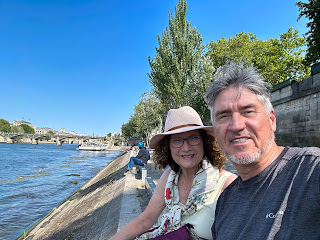 |
| Jet-lagged on the banks of the Seine, soon after we arrived. |
 |
| River houseboats |
 |
| 3,000-year-old Luxor Obelisk, gifted to France by Egypt in 1836. |
 |
| On foot in the 6th Arrondissement |
The city is divided into 20 administrative districts known as “arrondissements,” with each having an elected mayor. These arrondissements are arranged in a clockwise spiral pattern, often likened to a snail shell, starting from the center of the city. The 1st Arrondissement is situated on the Right Bank of the River Seine at the Louvre Palace. Our good friend, Rob, had recently stayed in the 6th Arrondissement with his family and highly recommended it. He described it as a relatively quiet, mostly residential district that embraced the luxuriant Luxembourg Garden. Most of the key attractions we wished to visit would be within a 25-minute walk from here. It sounded good to me—we booked a room at a small, quaint hotel adjacent to Luxembourg Garden.
 |
| Arrondissements of Paris |
 |
| 6th Arrondissement |
The 6th arrondissement has played a significant role throughout Parisian history. It is well known for its vibrant café culture and as a hub for revolutionary authors and poets in the early 20th century, including American Lost Generation writers like Hemingway and Fitzgerald (Café de Flore on Saint Germain Blvd was one of their favorite hangouts). It is also the home to the French intelligentsia and continues to be a major locale for art galleries and fashion stores. It is also one of the most expensive areas in Paris to live.
 |
| 6th Arrondissement |
 |
| A small-scale version of the Statue of Liberty in Luxembourg Gardens - 6th Arrondissement |
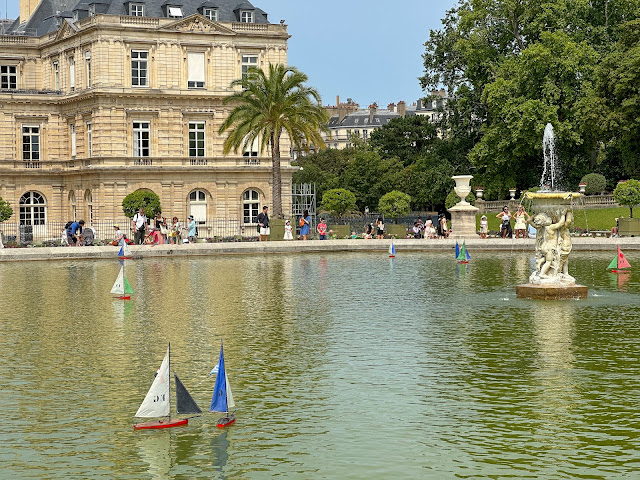 |
| Toy sailboats on the fountain pond of 300-year-old Luxembourg Palace - 6th Arrondissement |
The LOUVRE
Located on the Right Bank of the Seine River, the Louvre is home to some of the most iconic and celebrated artworks of Western civilization, including the Mona Lisa, Venus de Milo, and Winged Victory. With 35,000 works of art, it's the largest—and most-visited—museum in the world. But the sheer scale of the Louvre is also its biggest drawback. Trying to see everything in a single visit would be an exercise in futility—and we only had two days. Hence, we passed on it for this trip. Maybe next time.
 |
| Tuileries Garden with Louvre Palace in background. |
 |
| Louvre Palace |
Perhaps we didn't get to see the inside, but we wandered around the outside and took photos. The Louvre Palace has a rich, centuries-old history. Built in the late 12th century under Philip II, it served as the primary royal residence until 1546, when Francis I converted it into a display for the royal art collection. In 1682, Louis XIV moved to Versailles (in the country, 12 miles outside of Paris), leaving the Louvre as a museum for royal artworks. It was opened as a public art museum in 1793 after the French Revolution, marking a significant transition from royal palace to a national institution.
 |
| The Louvre, old and new. |
The ORSAY MUSEUM
The Orsay Museum is on the Left Bank of the Seine, across the river from the Louvre. It houses an impressive collection of French art dating from 1848 to 1914 and boasts the world's largest collection of Impressionist and post-Impressionist masterpieces. Here you will find the works of Monet, Degas, Renoir, Seurat, Gauguin, and the famously eccentric van Gogh, who cut his ear off to make an impression (no pun intended). Terry was certainly looking forward to the Orsay, as she is a big fan of the Impressionist heavyweights. Our museum guide, Nicolas, was an engaging art aficionado. He transformed our tour into an enlightening art appreciation class, deepening our understanding and enjoyment of the artwork. Without him, I would have been merely looking at paintings on the wall.
 |
|
The Orsay has a fascinating history intertwined with the transportation and architectural evolution of Paris. Originally built as the Orsay Railway Station in 1898, it served as a bustling terminus for the Paris-Orléans rail line. Over time, the station's short platforms became unsuitable for the new, longer mainline trains, and was downgraded to inner-city rail traffic just prior to World War II. Part of the building became a mailing center. Other parts were used to store junk. But overall, the building was falling into disrepair. Recognizing its historical significance, conservation groups lobbied to have the old station classified as a Historic Monument in 1978, protecting it from demolition. This paved the way for its conversion into an art museum, which opened in 1986. Today, the Orsay exemplifies adaptive reuse of historic architecture, blending its grand past as a transportation hub with its current role as a world-renowned museum. I like happy endings.
In 1867, French sculptor, Jean-Baptiste Carpeaux, was commissioned by the city of Paris to create a centerpiece for a fountain in the Luxembourg Garden. The bronze statue, which he called "Four Parts of the World Holding a Celestial Sphere," depicted a celestial sphere being held aloft by four female figures representing Europe, Asia, Africa, and America. As a staunch abolitionist, Carpeaux subtly incorporated a message into his work—the figure representing America (at right in photo above) is standing on the broken chain of slavery that is shackled to Africa's ankle. Overall, Parisians were not particularly fond of Carpeaux’s masterpiece, and he passed away soon after its completion. This is the way art often works—its value and significance are only appreciated after the artist has departed. Now it has a home in the Orsay.
 |
| Nicolas explains Edgar Degas’ Blue Dancers. |
Impressionist style originated with a group of Paris-based artists whose independent exhibitions brought them to prominence during the 1870s and 1880s. The name derives from the title of a Claude Monet work, Impression, Sunrise. Here are my personal favorites from a morning at the Orsay…
 |
Impression Sunrise, by Claude Monet - 1872
The painting that started an art movement. |
 |
| Sunlight Opening in Fog, by Claude Monet - 1904 |
 |
| Windmill Galette Ball, by Pierre-Auguste Renoir - 1876 |
 |
| Starry Night Over the Rhône, by Vincent van Gogh - 1888 |
 |
| The Circus, by Georges Seurat - 1891 |
 |
| Tahitian Girls, by Paul Gauguin - 1892 |
 |
| Profile of a Woman, by Henri de Toulouse-Lautrec - 1896 |
The ORANGERIE MUSEUM
The Orangerie Museum in the Tuileries Garden offers a contemplative space to immerse oneself in Impressionist and post-Impressionist art. Its centerpiece is Claude Monet's expansive Water Lily murals, which exemplify the artist's mastery of light and color. While the museum showcases works by other renowned artists as well, Monet's presence defines the space. Which is the reason we visited it.
 |
| This photo was taken from the Orangerie, looking across to the Orsay on other side of the river. |
The Orangerie was built in 1852 for storing the citrus trees in Tuileries Garden during the cold winters, and it later hosted diverse events like concerts, art exhibits, and dog shows (yes, dog shows). In 1922, it transitioned into providing a space for artists to display their works, breathing new life into the building. Monet—now in his eighties—was involved in the redesign process, integrating art and environment, with his Water Lily murals finding a permanent home. The museum opened in 1927, just a few months after Monet's passing.
Monet’s Water Lilies consists of eight panels. Each panel is 6½ feet high, spanning 296 feet in length once assembled. They are arranged in two oval rooms which form the infinity symbol. Overhead skylights allow the mural to be observed in natural light.
Famous Picasso paintings at the Orangerie...
 |
| Large Still Life, by Pablo Picasso - 1917 |
 |
| Woman with Tambourine, by Pablo Picasso - 1925 |
NOTRE-DAME CATHEDRAL
The Notre-Dame Cathedral is a 13th century marvel that has seen its fair share of tumultuous times. From being sacked during the French Revolution to the devastating fire that gutted much of it in 2019, this national treasure has endured. It has witnessed the might of medieval kings, the coronation of Emperor Napoleon, and the funerals of many presidents of the French Republic. Victor Hugo's iconic novel The Hunchback of Notre-Dame sparked a 19th century restoration effort, but today the cathedral remains closed for extensive rebuilding after the recent fire. The best Terry and I could do was stroll around the construction zone perimeter, where an official sign declared that it would be completed in time for the 2024 Summer Olympics. But I don’t know. Just looking at the scale of the project makes that timeline seem overly ambitious. (Our visit to Paris was the summer of ‘23, the year before the Olympics—and Notre-Dame repairs were not completed in time for the games. Reopening is now scheduled for December 2024.)
 |
| Major reconstruction underway (photo taken in July 2023). Scheduled to reopen December 8th, 2024. |
 |
| Medieval gargoyles and grotesques ward off evil from the cathedral. |
 |
“Why was I not made of stone like thee?”
Quasimodo in 1939 film, Hunchback of Notre Dame. |
The EIFFEL TOWER
The Eiffel Tower was certainly on our must-see list. It was the closest thing we did that resembled a Disneyland ride, but hey—it’s the EIFFEL TOWER! Constructed as the centerpiece for the 1889 World's Fair, its aesthetics initially faced snobbish criticism. However, it has since become a global French icon and one of the most recognizable structures in the world. In fact, it is also the most visited monument in the world with an entrance fee. So, yeah. Disneyland with a French twist.
The Eiffel Tower is named after its brilliant engineer, Gustave Eiffel, whose company designed and constructed it (Eiffel was also responsible for the iron framework inside the Statue of Liberty). At a staggering height of 1,083 feet, the wrought-iron lattice tower was an engineering marvel for its time, surpassing the Washington Monument to become the tallest man-made structure in the world, a title it held for 41 years until the Chrysler Building in New York City was completed in 1930.



The task of drawing the components was complicated by the intricate angles involved in the design and the degree of precision required. The position of rivet holes was specified to within one millimeter, and the angles worked out to one second of arc (1 arcsec = 0.000278°)—extremely strict tolerances for the day. The finished components arrived at the construction site on horse-drawn carts from a factory in a nearby Parisian suburb. All the pieces were then carefully bolted together and hoisted into place. In all, over 18,000 iron pieces were joined together using 2.5 million rivets.
 |
| Completion to first level - March, 1888 |
 |
| Completion to second level - August, 1888 |
 |
| Completion to third level - March, 1889 |
The tower has three levels, or platforms, with restaurants on the first and second. The third level stands 906 feet above ground, accessible by climbing over a thousand steps—or taking the elevators, which most visitors prefer. Initially, Gustave Eiffel had a private apartment on the third level, which offered stunning views in all directions. He entertained distinguished guests here during the World's Fair, including the Prince of Wales, Thomas Edison, French stage sensation, Sarah Bernhardt, and Buffalo Bill Cody, whose Wild West show was an attraction at the Exposition. If anyone wants to know—we took the elevators.
 |
| The view from the top. |
 |
| One of the last things we did in Paris was a champagne river cruise. Santé! |
BULLET TRAIN to METZ
With our whirlwind Paris fling coming to an end, it was time to pack up and head to the train station. Our next destination was Metz, which is where the bike-and-barge tour would begin in a couple of days. At the station we hopped on the TGV, a high-speed rail system that would cover the stretch to Metz in just 90 minutes. The prospect of hurtling through the countryside at speeds up to 200 mph was exhilarating. We settled into a relaxing, smooth ride, watching fields of grain fly past the windows. The seats were comfortable. I dozed off. And in no time at all, we had arrived at our destination! (We don’t have trains like this in the USA because? Anybody?)
Bound for Metz...
 |
| Metz and the Mosel River. |
Room with a view.
After the hustle and bustle of Paris, it was a relief to check into our hotel and immediately start to unwind. Our room, tucked up on the top floor (no elevator) was small and vintage, but afforded a breathtaking view of a 600-year-old cathedral across the plaza. Welcome to Metz. That evening, after dinner, we stepped out to explore a town that seemed to flow at a more peaceful pace. Graceful swans glided along the Mosel River. Children played in a nearby park. We could sense the anticipation for tomorrow’s Bastille Day celebration, as merchants bustled about, preparing. It was exactly the tranquil respite we needed after the energy of Paris. We simply wandered and soaked up the vibe. Tomorrow was another day, and another chapter.
 |
| Temple Neuf. Completed in 1904 when Metz was a part of Germany. |
























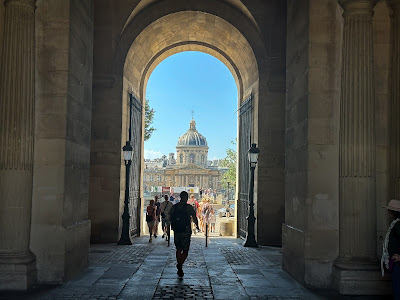












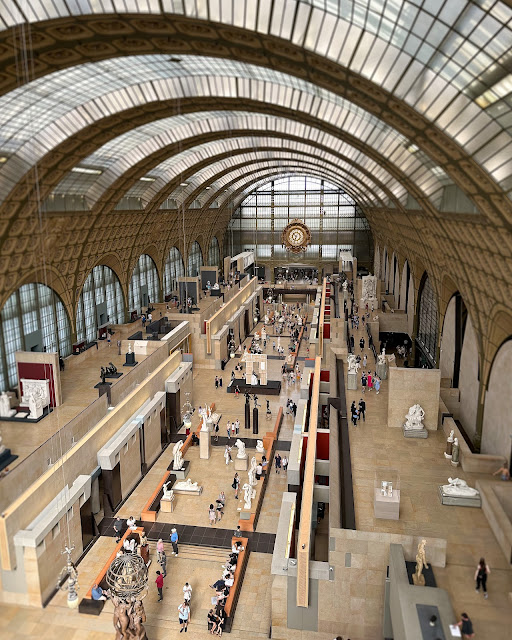




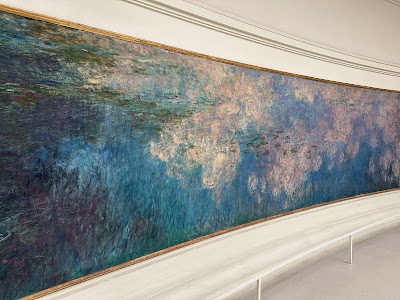













No comments:
Post a Comment